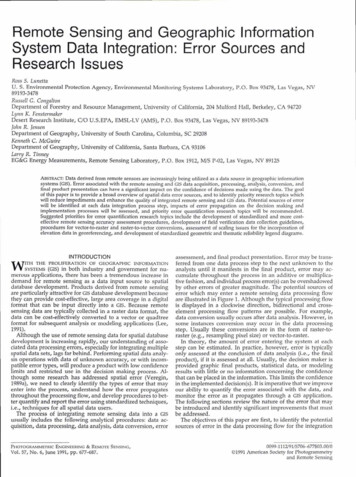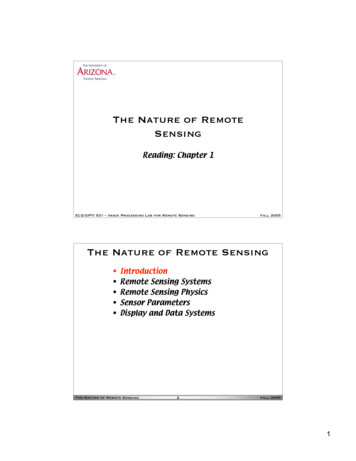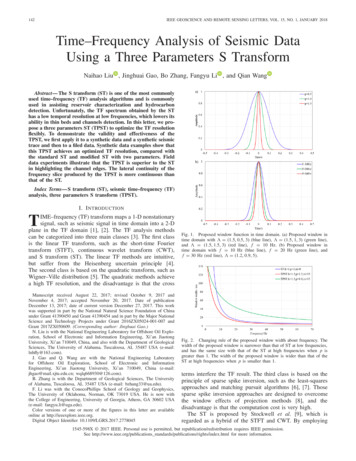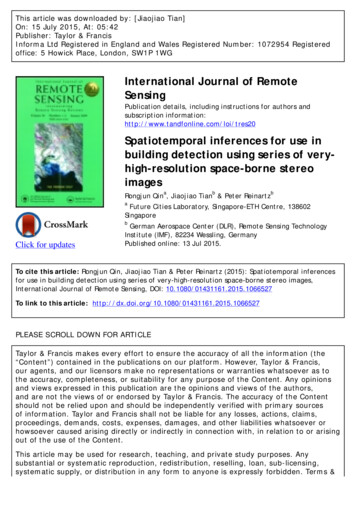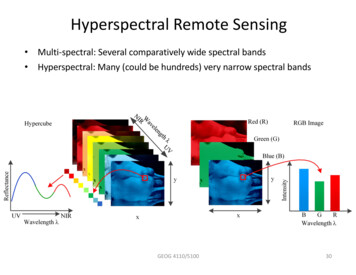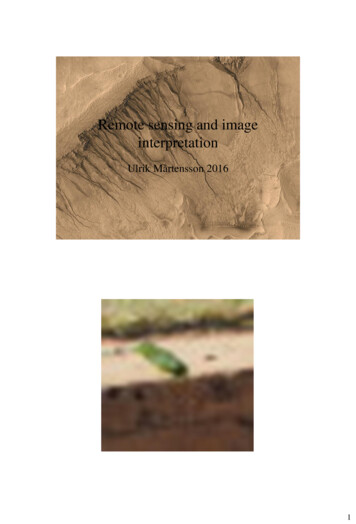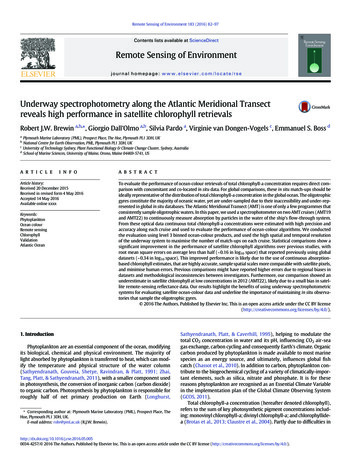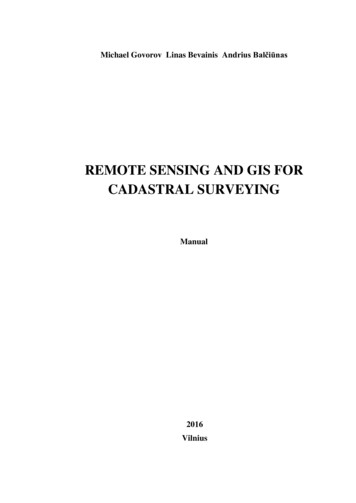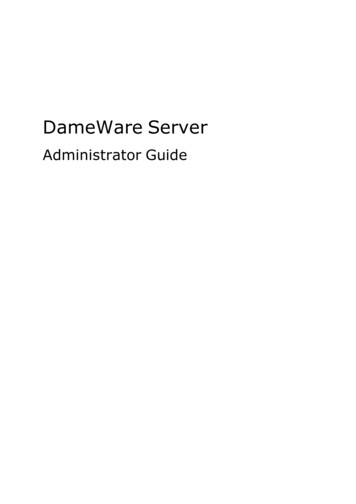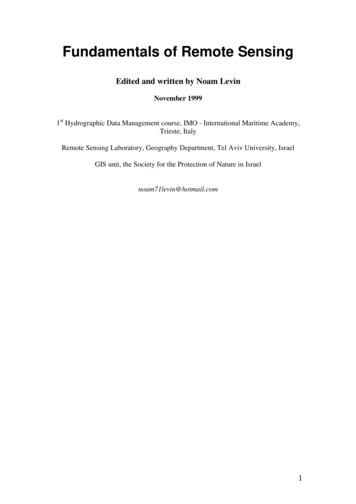
Transcription
Fundamentals of Remote SensingEdited and written by Noam LevinNovember 19991st Hydrographic Data Management course, IMO - International Maritime Academy,Trieste, ItalyRemote Sensing Laboratory, Geography Department, Tel Aviv University, IsraelGIS unit, the Society for the Protection of Nature in Israelnoam71levin@hotmail.com1
Table of .3.71.3.8DefinitionComparison to maps, GIS, aerial photography / Photogrammetry, SONARSatellite Images Vs MapsRemote Sensing Vs GISRemote Sensing Vs Aerial Photography / PhotogrammetryRemote Sensing Vs SONARApplications in generalAgricultureForestryGeologyHydrologySea IceLand Cover & Land UseMappingOceans & Coastal netic .5Electromagnetic energyInteraction mechanismsLaws regarding the amount of energy radiated from an objectPlanck Radiation LawWien’s displacement lawBlack body concept, Emissivity and Radiant TemperatureElectromagnetic SpectrumWavelength bandsAtmosphere effectsScatteringAbsorptionReflectance spectraMixturesGrain Size EffectsThe Continuum and Band DepthContinuum-Removed Spectral Feature ComparisonViewing te Characteristics: Orbits and SwathsScanner Sensor SystemsSpatial Resolution, Pixel Size, and ScaleSpectral / Radiometric resolutionSpectral charaecteristicsSpectral rangeSpectral bandwidthSpectral samplingSignal-to-noise ratioTemporal ResolutionOverview of different sensors – satellites and airborneComparison TableWeather Satellites/SensorsGOESNational Oceanic and Atmospheric Administration's AdvancedVery High Resolution Radiometer343437384040414244454546464747482
43.7.1.43.7.1.4.13.7.1.4.23.7.1.4.33.7.1.5Land Observation Satellites/SensorsLandsat Multispectral ScannerLandsat Thematic MapperSysteme Probatoire d'Observation de la Terra (SPOT) HighResolution Visible SensorIndian Remote SensingIKONOSMarine Observation Satellites/SensorsCoastal Zone Colour Scanner (CZCS)MOSSeaWiFSLaser fluorosensor - another kind of sensorHyperspectral sensorsCompact Airborne Spectrographic Imager CASIDigital Airborne Imaging Spectrometer DAIS 7915AVIRIS Airborne Visible InfraRed Imaging SpectrometerSynthetic Aperture Radar 44.3.2.54.3.2.64.3.2.7Radiometric calibrationMain elements of sensor calibrationAbsolute radiometric calibration – from radiance to DN and backUniformity calibrationSpectral calibrationGeometric calibrationCalibration approachesPrelaunch calibrationOnboard calibrationVicarious calibrationAtmospheric - from radiance to reflectance or to temperatute\emissivityCalibrating images from different dates to like-valuesInternal Average Realtive Reflectance (IARR)Flat FieldEmpirical lineAtmospheric modellingBand transmittance computer modelsLine-by-line modelsMODTRAN2nd simulation of satellite signal in the solar spectrum – 6s codeATmospheric REMoval program (ATREM)ATCORTemperature calibration of imagesThermal properties of materialsRetrieval of temperature and emissivity from radiance in thermal imagesGeometric correctionsGeometric registrationPlane transformationsPolynomial transformationsTriangulationGround Control PointsResamplingRelief displacementLANDSAT – geometric characteristicsTM geometric accuracyTM data processing levelsRaw dataSystem corrected productsGeocoded productsLevel A – without ground control pointsLevel B – with ground control 535353545454553
l C – with ground control points plus DTMSPOT – processing levelsLevel 1A – no geometric correctionLevel 1B - compensating internal geometric distortionsLevel 1AP - Photographic product for photogrametric use withanalogue devicesLevel 2A – entry level for cartographic products – projected,no control pointsLevel 2B – geocoded product, projected, with ground control pointsLevel ORTHO - The ultimate level of preprocessing for the bestcartographic accuracy: correction of the residual parallax errorsbrought by the reliefParametric Geocoding (based on the PARGE alogrithm)5Image 5.3.55.3.5.15.3.5.2Storage formatsImage enhancment:Histogram, stretching, colour palettesContrast enhancementLinear StretchHistogram equalizationPiece-wise linear stretchRGB false colour compositColour Definition Models, fusion of TM and SPOTColour Definition ModelsRed, Green, and Blue (RGB)Hue, Saturation, and Lightness (HSL)CMYK ModelFusion by HSV TransformationSpatial filters – noise reduction (low-pass), edge enhancment (high-pass)The basic principles of a filterLow pass filtersHigh pass filtersMulti-band operationsImage ratios: Brightness variationsNormalized Difference Vegetation IndexPrincipal components analysisImage classificationDensity slicingMulti-spectral image classificationSupervised ClassificationSamplingClassificationAccuracy assessmentUnsupervised classification (clustering)UnmixingModeling mixed spectraPractical unmixing 261276Active Remote de Looking Airborne Radar (SLAR):FrequenciesPolarizationViewing Geometry and Spatial ResolutionRadar image distortionsTarget interaction and image appearanceRadar image propertiesAdvanced Radar 4.3.3.692939393944
7Remote Sensing Applications for the sea(passive and SLAR)1487.17.27.2.17.2.27.37.3.17.47.4.17.5Sea Surface TemperatureOil Spill DetectionCase study 1 – oil slickCase study 2 – oil seepIce motion and monitoringCase study (example): Operational ice monitoring with ERS-1 SARMapping the sea floor (bathymetry)Case study – SHOM’s nautical space chart (La spatiocarte marine)Vessel detection1481501511511521531551551588Digital video Remote .88.8.18.8.2A little historyGeneral advantages of using videoThe video imageCharge-Coupled DevicesThe geometric resolution of videoAirborne video data acquisitionTypes of airborne video systemsMultiband informationMultiplex systemsSingle camera systemsThe Silvacam cameraApplicationsCoastal monitoring in the NetherlandsThe Southwest Washington Coastal Erosion Study,and the ARGUS imetry1729.19.29.39.3.1Laser altimetryRadar altimetryRadar altimetry over the oceansMeasuring Ocean Topography for Understanding and PredictingClimate ChangeData sourcesGeosat follow-onTOPEX/PoseidonMission requirementsSensors on board the TOPEX/POSEIDONOrbit of the TOPEX/POSEIDONData retrievalJasonERS-2NRL layered ocean modelModular ocean data assimilation system (MODAS)Data processingInitial Data ProcessingInterpolationTide removalOrbit error removalReferencing to a consistent meanAltimetry products and derived productsDynamic Sea Surface Topography - (from Altitude)Sea Surface VariabilityWind Speed - (from backscatter coefficient)ScatterometryOcean circulationSignificant Wave Height - (from Wave Form Leading 841841861871885
9.5.5.2.59.5.5.2.6WatervaporMarine gravity and sea-floor topographyGlobal Bathymetric Prediction for Ocean Modelling andMarine GeophysicsAirborne laser scanning (ALS)Introduction – laser principlesPulse lasersWavelengthScanningPosition and orientation systemTypical processing stepsSome extended laser capabilitiesA short overview of applicationsAirborne Laser Scanning vs Photogrammetry – a comparisonLaser remote sensing of forest structureMulti-Beam Laser Altimeter (MBLA) - The Lidar Instrumentfor the Vegetation Canopy Lidar (VCL)Scanning laser mapping of the coastal zoneHistoric developmentWorking principlesBenefitsCase study: The ALACE project - Airborne LIDAR Assessmentof Coastal Erosion ProjectIHO and FEMA standards, and their relation to ALS technologyIHO S-44FEMAAIRBORNE LIGHT DETECTION AND RANGING SYSTEMS General Guidelines for UsePerformance StandardsGPS ControlPost-Processing of DataQuality Control/Quality 2GIS metadataGIS metadata worked example – Bathymetry of the Gulf ofCarpentaria and the Arafura SeaRemote Sensing metadata11References and links22411.111.211.311.411.5Basic books about remote sensingRemote Sensing journalsOn-line tutorialsRemote Sensing softwaresOther Remote Sensing 62082092132132152152152162162172182202226
Thanks:First, I would like to express my thanks to the following people, for making this workpossible: The staff of IMO-IMA, for supplying me with the appropriate working conditions(free access to the Internet, the academy’s library) and helping whenever needed,the staff of the Earth Sciences library of the Trieste university, for their help inlending books and making photocopies of articles,all the people and institutions that maintain internet sites, and publish on-linearticles, tutorials, technical documentations, etc (references mentioned along thetext, the principal sources at the end of the text),Dr. Eyal Ben Dor from the geography department of Tel Aviv’s university forintroducing me to the field of Remote Sensing, andto my family and friends.7
Preface:§Craig J.M. (1998), The application of satellite imagery in support of nautical charting; pastexperience and future possibilities - a practical view, International Hydrographic Review,LXXV(1), no. 142, pp. 95-105The field of Remote Sensing is very wide, both in the data acquisition methods, dataprocessing procedures and techniques and the applications it is used for; it is also afast developing field, in all the above themes. This text is therefore intended to giveonly a general overview about several subjects, yet I hope, an extensive one, coveringall the important topics regarding Remote Sensing of the surface of the Earth. The textalso attempts to give the reader an understanding of the capabilities and limitations ofRemote Sensing. Very few equations and formulas will be given in the text, as thefocus will be on understanding the basic ideas. The main subjects covered are: The role Remote Sensing plays in our understanding of the Earth and the naturaland human processes affecting it,The radiometric and geometric principles of Remote Sensing,The principal sensors used, and their characteristics, in passive and active,imaging and non-imaging Remote Sensing, on airborne or on satellite platforms,from monochromatic to hyperspectral,The pre processing phase of data: radiometric, atmospheric, geometric and noisescorrections, andThe image processing phase of data: visualisation, enhancement and classification.Due to the wide scope covered, the subjects could not be covered in details and theinterested reader should turn to the relevant literature.Detailed examples of Remote Sensing applications will be given in areas which havedirect importance for either hydrography or oceanography. The advantages ofacquiring information by Remote Sensing apply, irrespective of platform or sensor,also for hydrography:1. It is cheaper than conventional surveying;2. It is safer than hydrographic surveying in shoal areas such as coral reefs;3. It is capable of change detection in rapidly developing ports and regularmonitoring of mobile areas such as deltas and sandbanks;4. World-wide coverage is comercially available, without security, political, orcopyright restrictions, enabling dataa acquisition from remote areas;5. The inherent geometry and therefore the relative positioning of features within asingle scene is generally very good.Through out the work all the references from which I have taken material are given,though not in the formal academic way.8
1. Introduction:1.1 .html1. The Definition of Remote Sensing In the broadest sense, the measurement oracquisition of information of some property of an object or phenomenon, by arecording device that is not in physical or intimate contact with the object orphenomenon under study; e.g., the utilization at a distance (as from aircraft,spacecraft, or ship) of any device and its attendant display for gatheringinformation pertinent to the environment, such as measurements of force fields,electromagnetic radiation, or acoustic energy. The technique employs suchdevices as the camera, lasers, and radio frequency receivers, radar systems, sonar,seismographs, gravimeters, magnetometers, and scintillation counters.2. The practice of data collection in the wavelengths from ultraviolet to radioregions. This restricted sense is the practical outgrowth from airbornephotography. Sense (1) is preferred and thus includes regions of the EM spectrumas well as techniques traditionally considered as belonging to RS/satremot.htmlAs humans, we are intimately familiar with remote sensing in that we rely on visualperception to provide us with much of the information about our surroundings. Assensors, however, our eyes are greatly limited by 1) sensitivity to only the visiblerange of electromagnetic energy; 2) viewing perspectives dictated by the location ofour bodies; and 3) the inability to form a lasting record of what we view. Because ofthese limitations, humans have continuously sought to develop the technologicalmeans to increase our ability to see and record the physical properties of ourenvironment.Beginning with the early use of aerial photography, remote sensing has beenrecognized as a valuable tool for viewing, analyzing, characterizing, and makingdecisions about our environment. In the past few decades, remote sensing technologyhas advanced on three fronts: 1) from predominantly military uses to a variety ofenvironmental analysis applications that relate to land, ocean, and atmosphere issues;2) from (analog) photographic systems to sensors that convert energy from many partsof the electromagnetic spectrum to electronic signals; and 3) from aircraft to satelliteplatforms.Today, we define satellite remote sensing as the use of satellite-borne sensors toobserve, measure, and record the electromagnetic radiation reflected or emitted by theEarth and its environment for subsequent analysis and extraction of information.9
1.2 Comparison to maps, GIS, aerial photography / Photogrammetry, SONARHere will be given the main points of similarity and difference between the field ofRemote Sensing (analysis and images) and the fields/products mentioned above.1.2.1 Satellite Images Vs Maps§§Anson R.W. and Ormeling F.J., (1993), Basic Cartography – for students and technicians, Vol 1.,ElsevierPortugaly Y. (1996), “The maps hidden from the eye”, Mishkafayim, 27, pp. 44-47 (in Hebrew)According to the International Cartographic Union, a map is “a conventionalisedimage representing selected features or characteristics of geographical reality,designed for use when spatial relationships are of primary importance”. Thisdefinition does declare that in every map there’s a process of selection present (and inaddition - symbolization, abstraction and generalization), but also keeps the aura ofscientific accuracy of a map. But, we should remember, that “a map shows us theworld as we know it, and what we know, is a very complex subject, that is comprisedof: The limits of matter, technology and our measurement tools, what we believe that exists, what we think to be important, and what we want and aspire to”Thus, a map is a subjective, for we always decide what to put on it, and how torepresent it. A Remote Sensing image in contrast, is an objective recording of theElectromagnetic reaching the sensor.Another important difference, is that a map is a projection of the earth on paper,without any relief displacements, while in a Remote Sensing image both reliefdisplacements and geometrical distortions.1.2.2 Remote Sensing Vs GISGIS (Geographic Information System) is a kind of software that enables: The collection of spatial data from different sources (Remote Sensing being one ofthem). Relating spatial and tabular data. Performing tabular and spatial analysis. Symbolize and design the layout of a map.A GIS software can handle both vector and raster data (some handle only one ofthem). Remote Sensing data belongs to the raster type, and usually requires specialdata manipulation procedures that regular GIS does not offer. However, after aRemote Sensing analysis has been done, its results are usually combined within a GISor into database of an area, for further analysis (overlaying with other layers, etc). Inthe last years, more and more vector capabilities are being added to Remote Sensingsoftwares, and some Remote Sensing functions are inserted into GIS modules.1.2.3 Remote Sensing Vs Aerial Photography / PhotogrammetryBoth systems gather data about the upper surface of the Earth, by measuring theElectromagnetic radiation, from airborne systems. The following major differencescan be given: Aerial photos are taken by an analog instrument: a film of a (photogrammetric)camera, then scanned to be transformed to digital media. Remote Sensing data isusually gathered by a digital CCD camera.10
The advantage of a film is its high resolution (granularity), while the advantage ofthe CCD is that we measure quantitatively the radiation reaching the sensor(radiance values, instead of a gray-value scale bar). Thus, Remote Sensing datacan be integrated into physical equations of energy-balance for example.An Aerial photograph is a central projection, with the whole picture taken at oneinstance. A Remote Sensing image is created line after line; therefor, thegeometrical correction is much more complex, with each line (or even pixel)needing to be treated as a central projection.Aerial photos usually gather data only in the visible spectrum (there are alsospecial films sensitive to near infrared radiation), while Remote Sensing sensorscan be designed to measure radiation all along the Electromagnetic spectrum.Aerial photos are usually taken from planes, Remote Sensing images also fromsatellites.Both systems are affected by atmospheric disturbances. Aerial photos mainly fromhaze (that is, the scattering of light – the process which makes the sky blue),Remote Sensing images also from processes of absorption. Atmosphericcorrections to Aerial photos can be made while taking the picture (using a filter),or in post-processing, as in done Remote Sensing. Thermal Remote Sensingsensors can operate also at nighttime, and Radar data is almost weatherindependent.In Photogrammetry the main efforts are dedicated for the accurate creation of a 3dmodel, in order to plot with high accuracy the location and boundaries of objects,and to create a Digital Elevation Model, by applying sophisticated geometriccorrections. In Remote Sensing the main efforts are dedicated for the analysis ofthe incoming Electromagnetic spectrum, using atmospheric corrections,sophisticated statistical methods for classification of the pixels to differentcategories, and analysing the data according to known physical processes thataffect the light as it moves in space and interacts with objects.Remote Sensing images are very useful for tracking phenomena on regional,continental and even global scale, using the fact that satellites cover in each imagea wide area, and taking images all the time (whether fixed above a certain point, or“revisiting” the same place every 15 days (for example).Remote Sensing images are available since the early 1970’s. Aerial photos,provide a longer time span for landscape change detection (the regular coverage ofIsrael by Aerial photos started in 1944/5, for example, with many Aerial photostaken also during World War 1).Remote Sensing images are more difficult to process, and require trainedpersonnel, while aerial photographs can be interpreted more easily.1.2.4 Remote Sensing Vs SONARThe SONAR can also be considered as Remote Sensing – that is, studying thesurfaces of the sea (bathymetry and sea bed features) from a distance. The SONAR isan active type of Remote Sensing (like Radar; Not depending on an external source ofwaves, measuring the time between the transmission and reception of waves producedby our instruments, and their intensity), but using sound waves, and notElectromagnetic radiation.Both systems transmit waves through an interfering medium (water, air), that addsnoise to the data we are looking for, and there for corrections must be applied to the11
raw data collected. In Remote Sensing however, Radar is considered to be almostweather independent, and atmospheric disturbances affect mainly passive RemoteSensing). To make these necessary corrections, both systems depend on callibrationfrom field data (be it salinity, temperature and pressure measured by the ship whilesurveying, or measurements of the atmospheric profile parameters by ameteorological radiosonde for example).Sonar’s are mainly used to produce the bathymetry of the sea, while Remote Sensingtechniques are focusing more on identification of the material’s properties than on itsheight.Echo-sounders (single or multi-beam) can be compared to Airborne Laser Scanning –both of them create point (vector) data containing X,Y,Z, that needs to be further postprocessed in order to remove noise (spikes). An added complexity when dealing withbathymetry (as opposed to topography) is the need for tide corrections.Side Scan SONAR can be compared to Side Looking Aperture RADAR, both of themcreating images (raster) analyzing the surface.Another major difference is that in Remote Sensing the results of the analysis can becompared easily to the field (aerial photos, maps, field measurments), while inSONAR the underlying bottom of the sea is hidden from us, and we depend totally onthe data gathered.1.3 Applications in utorial/indexe.htmlAs will be learned in the section on sensors, each one is designed with a specificpurpose. With optical sensors, the design focuses on the spectral bands to becollected. With radar imaging, the incidence angle and microwave band used plays animportant role in defining which applications the sensor is best suited for.Each application itself has specific demands, for spectral resolution, spatial resolution,and temporal resolution. There can be many applications for Remote Sensing, indifferent fields, as described below. In the body of this tutorial of Remote Sensing,some applications relevant for hydrography and oceanography will be given in moredetail.1.3.1 AgricultureAgriculture plays a dominant role in economies of both developed and undevelopedcountries. Satellite and airborne images are used as mapping tools to classify crops,examine their health and viability, and monitor farming practices. Agriculturalapplications of remote sensing include the following: crop type classification crop condition assessment crop yield estimation mapping of soil characteristics mapping of soil management practices compliance monitoring (farming practices)1.3.2 ForestryForests are a valuable resource providing food, shelter, wildlife habitat, fuel, and dailysupplies such as medicinal ingredients and paper. Forests play an important role inbalancing the Earth's CO2 supply and exchange, acting as a key link between theatmosphere, geosphere, and hydrosphere.12
Forestry applications of remote sensing include the following: reconnaissance mapping:Objectives to be met by national forest/environment agencies include forest coverupdating, depletion monitoring, and measuring biophysical properties of foreststands. Commercial forestry:Of importance to commercial forestry companies and to resource managementagencies are inventory and mapping applications: collecting harvest information,updating of inventory information for timber supply, broad forest type, vegetationdensity, and biomass measurements. Environmental monitoring:Conservation authorities are concerned with monitoring the quantity, health, anddiversity of the Earth's forests.1.3.3 GeologyGeology involves the study of landforms, structures, and the subsurface, to understandphysical processes creating and modifying the earth's crust. It is most commonlyunderstood as the exploration and exploitation of mineral and hydrocarbon resources,generally to improve the conditions and standard of living in society.Geological applications of remote sensing include the following: surficial deposit / bedrock mapping lithological mapping structural mapping sand and gravel (aggregate) exploration/ exploitation mineral exploration hydrocarbon exploration environmental geology geobotany baseline infrastructure sedimentation mapping and monitoring event mapping and monitoring geo-hazard mapping planetary mapping1.3.4 HydrologyHydrology is the study of water on the Earth's surface, whether flowing above ground,frozen in ice or snow, or retained by soilExamples of hydrological applications include: wetlands mapping and monitoring, soil moisture estimation, snow pack monitoring / delineation of extent, measuring snow thickness, determining snow-water equivalent, river and lake ice monitoring, flood mapping and monitoring, glacier dynamics monitoring (surges, ablation) river /delta change detection drainage basin mapping and watershed modelling13
irrigation canal leakage detectionirrigation scheduling1.3.5 Sea IceIce covers a substantial part of the Earth's surface and is a major factor in commercialshipping and fishing industries, Coast Guard and construction operations, and globalclimate change studies.Examples of sea ice information and applications include: ice concentration ice type / age /motion iceberg detection and tracking surface topography tactical identification of leads: navigation: safe shipping routes/rescue ice condition (state of decay) historical ice and iceberg conditions and dynamics for planning purposes wildlife habitat pollution monitoring meteorological / global change research1.3.6 Land Cover & Land UseAlthough the terms land cover and land use are often used interchangeably, theiractual meanings are quite distinct. Land cover refers to the surface cover on theground, while Land use refers to the purpose the land serves. The properties measuredwith remote sensing techniques relate to land cover, from which land use can beinferred, particularly with ancillary data or a priori knowledge.Land use applications of remote sensing include the following: natural resource management wildlife habitat protection baseline mapping for GIS input urban expansion / encroachment routing and logistics planning for seismic / exploration / resource extractionactivities damage delineation (tornadoes, flooding, volcanic, seismic, fire) legal boundaries for tax and property evaluation target detection - identification of landing strips, roads, clearings, bridges,land/water interface1.3.7 MappingMapping constitutes an integral component of the process of managing landresources, and mapped information is the common product of analysis of remotelysensed data.Mapping applications of remote sensing include the following: Planimetry:Land surveying techniques accompanied by the use of a GPS can be used to meethigh accuracy requirements, but limitations include cost effectiveness, anddifficulties in attempting to map large, or remote areas. Remote sensing provides ameans of identifying and presenting planimetric data in convenient media andefficient manner. Imagery is available in varying scales to meet the requirementsof many different users. Defence applications typify the scope of planimetry14
applications - extracting transportation route information, building and facilitieslocations, urban infrastructure, and general land cover.digital elevation models (DEM's):Generating DEMs from remotely sensed data can be cost effective and efficient. Avariety of sensors and methodologies to generate such models are available andproven for mapping applications. Two primary methods if generating elevationdata are 1. Stereogrammetry techniques using airphotos (photogrammetry), VIRimagery, or radar data (radargrammetry), and 2. Radar interferometry.Baseline thematic mapping / topographic mapping:As a base map, imagery provides ancillary information to the extractedplanimetric or thematic detail. Sensitivity to surface expression makes radar auseful tool for creating base maps and providing reconnaissance abilities forhydrocarbon and mineralogical companies involved in exploration activities. Thisis particularly true in remote northern regions, where vegetation cover does notmask the microtopography and general
4.3.3.6 Level ORTHO - The ultimate level of preprocessing for the best cartographic accuracy: correction of the residual parallax errors brought by the relief 93 4.3.4 Parametric Geocoding (based on the PARGE alogrithm) 94 5 Image processing 98 5.1 Storage formats 98 5.2 Image enhancm


